heating PONTIAC BONNEVILLE 1997 Owners Manual
[x] Cancel search | Manufacturer: PONTIAC, Model Year: 1997, Model line: BONNEVILLE, Model: PONTIAC BONNEVILLE 1997Pages: 405, PDF Size: 18.83 MB
Page 68 of 405
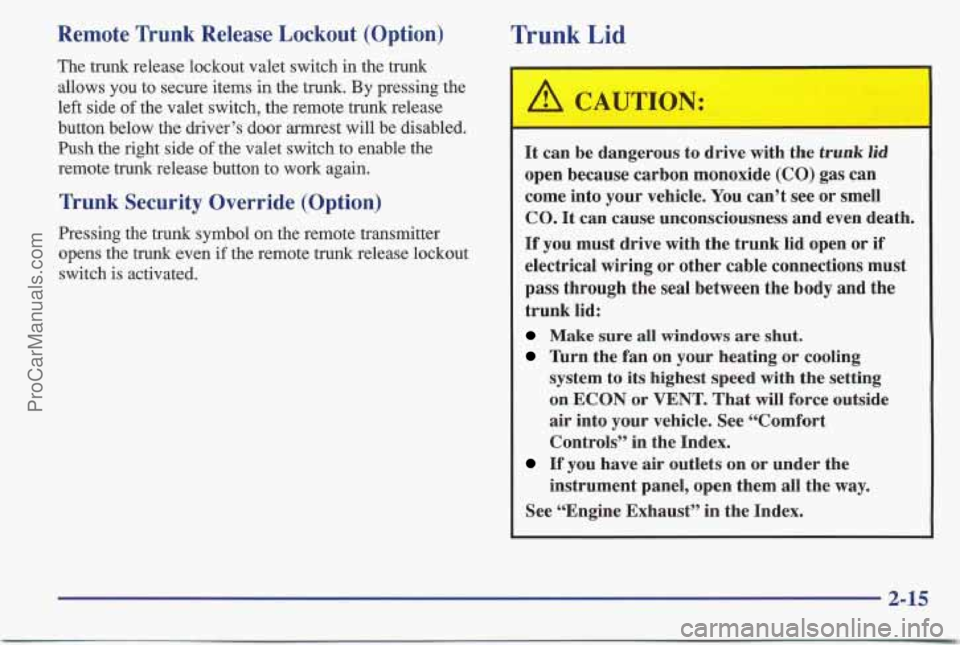
Remote Trunk Release Lockout (Option)
The trunk release lockout valet switch in the trunk
allows you to secure items
in the trunk. By pressing the
left side
of the valet switch, the remote trunk release
button below the driver’s door armrest will be disabled.
Push the right side
of the valet switch to enable the
remote trunk release button to work again.
Trunk Security Override (Option)
Pressing the trunk symbol on the remote transmitter
opens the trunk even if the remote
trunk release lockout
switch is activated.
Trunk Lid
It can be dangerous to drive with the trunk lid
open because carbon monoxide (CO) gas can
come into your vehicle.
You can’t see or smell
CO. It can cause unconsciousness and even death.
If you must drive with the trunk lid open or if
electrical wiring or other cable connections must
pass through the seal between the body and the
trunk lid:
Make sure all windows are shut.
”urn the fan on your heating or cooling
system to its highest speed with the setting
on
ECON or VENT. That will force outside
air into your vehicle. See “Comfort
Controls” in the Index.
If you have air outlets on or under the
instrument panel, open them all the way.
See “Engine Exhaust’’ in the Index.
ProCarManuals.com
Page 107 of 405
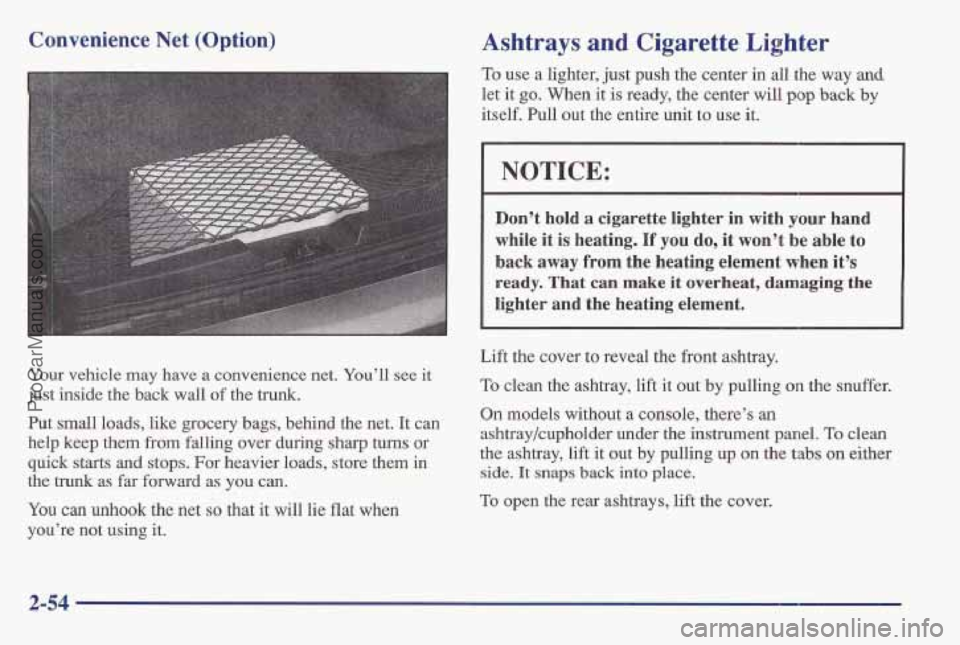
Convenience Net (Option)
Your vehicle may have a convenience net. You’ll see it
just inside the back wall of the trunk.
Put small loads, like grocery bags, behind the net.
It can
help keep them from falling
over during sharp turns or
quick starts
and stops. For heavier loads, store them in
the trunk as far forward as you can.
You can unhook the net so that it will lie flat when
you’re not using
it.
Ashtrays and Cigarette Lighter
To use a lighter, just push the center in all the way and
let it go. When it is ready, the center will pop back by
itself. Pull out the entire unit to use it.
I NOTICE:
Don’t hold a cigarette lighter in with your hand
while it is heating.
If you do, it won’t be able to
back away from the heating element when it’s
ready. That can make it overheat, damaging the
lighter and the heating element.
Lift the cover to reveal the front ashtray.
To clean the ashtray, lift it out by pulling on the snuffer.
On models without a console, there’s an
ashtray/cupholder under the instrument panel.
To clean
the ashtray, lift it out by pulling up
on the tabs on either
side. It snaps back into place.
To open the rear ashtrays, lift the cover.
2-54
ProCarManuals.com
Page 123 of 405
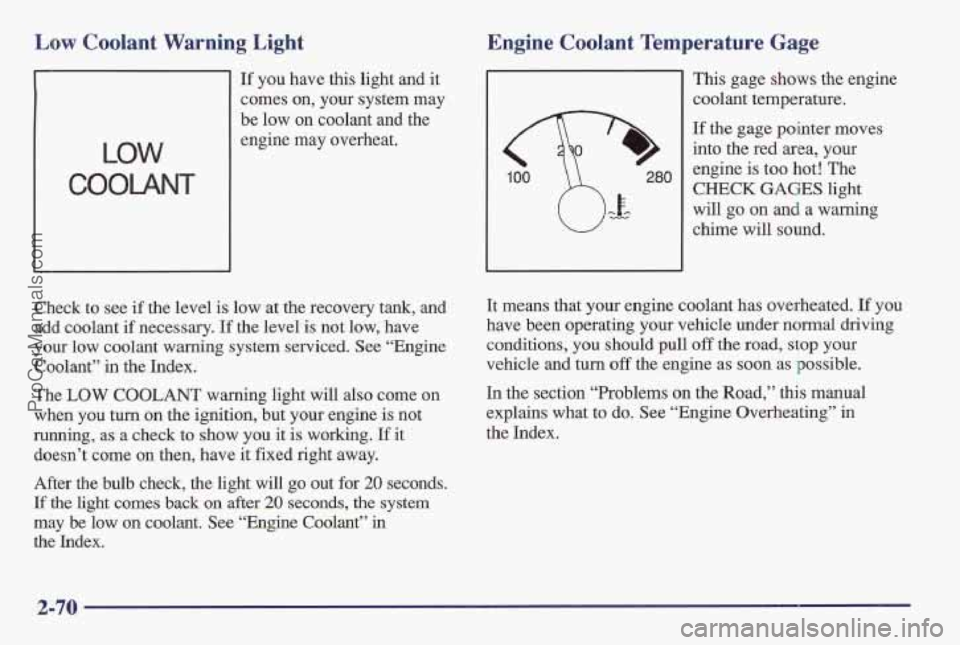
Low Coolant Warning Light
LOW
COOLANT
If you have this light and it
comes on, your system may
be low on coolant and the
engine may overheat.
Check
to see if the level is low at the recovery tank, and
add coolant
if necessary. If the level is not low, have
your low coolant
warning system serviced. See “Engine
Coolant” in the Index.
The
LOW COOLANT warning light will also come on
when you turn on the ignition, but your engine
is not
running, as a check to show you it is working. If it
doesn’t come on then, have
it fixed right away.
After the bulb check, the light will
go out for 20 seconds.
If the light comes back on after 20 s’ecoaads, the system
may be low
on coolant. See “Engine COQ~~”~II
the Index.
.. .-,.%.. - ,
Engine Coolant Temperature Gage
100 280
This gage shows the engine
coolant temperature.
If the gage pointer moves
into the red area, your
engine is too
hot! The
CHECK GAGES light
will go on and a warning
chime
will sound.
It means that your engine coolant has overheated. If you
have been operating your vehicle under normal driving
conditions, you should pull
off the road, stop your
vehicle and turn
off the engine as soon as possible.
In the section “Problems on the Road,”
this manual
explains what to do. See “Engine Overheating’’ in
the Index.
2-70
ProCarManuals.com
Page 142 of 405
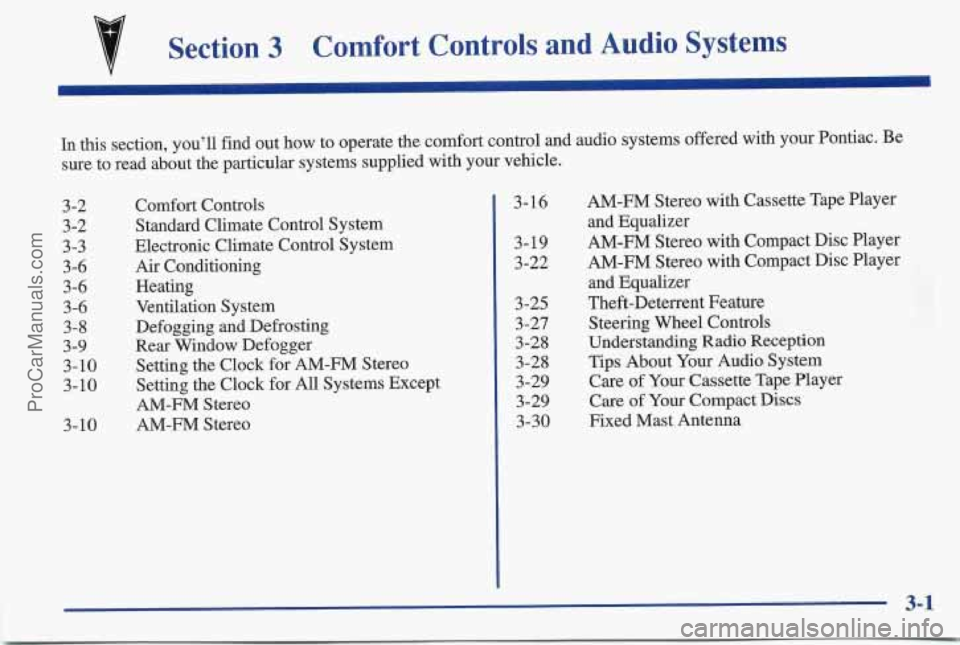
Section 3 Comfort Controls and Audio Systems
In this section, you’ll find out how to operate the comfort control and audio systems offered with your Pontiac. Be
sure to read about the particular systems supplied with your vehicle.
3-2 3-2
3-3
3-6 3-6
3-6
3-8
3-9
3-10 3-10
3-10 Comfort Controls
Standard Climate Control System
Electronic Climate Control System Air Conditioning
Heating
Ventilation System
Defogging and Defrosting
Rear Window Defogger
Setting the Clock for AM-FM Stereo
Setting the Clock for All Systems Except
AM-FM Stereo
AM-FM Stereo 3-16
3-19 3-22
3-25 3-27
3-28
3-28 3-29 3-29
3-30 AM-FM Stereo with Cassette
Tape Player
and Equalizer
AM-FM Stereo with Compact Disc Player AM-FM Stereo with Compact Disc Player
and Equalizer
Theft-Deterrent Feature Steering Wheel Controls
Understanding Radio Reception
Tips About Your Audio System
Care of Your Cassette Tape Player
Care
of Your Compact Discs
Fixed Mast Antenna
3-1
ProCarManuals.com
Page 143 of 405
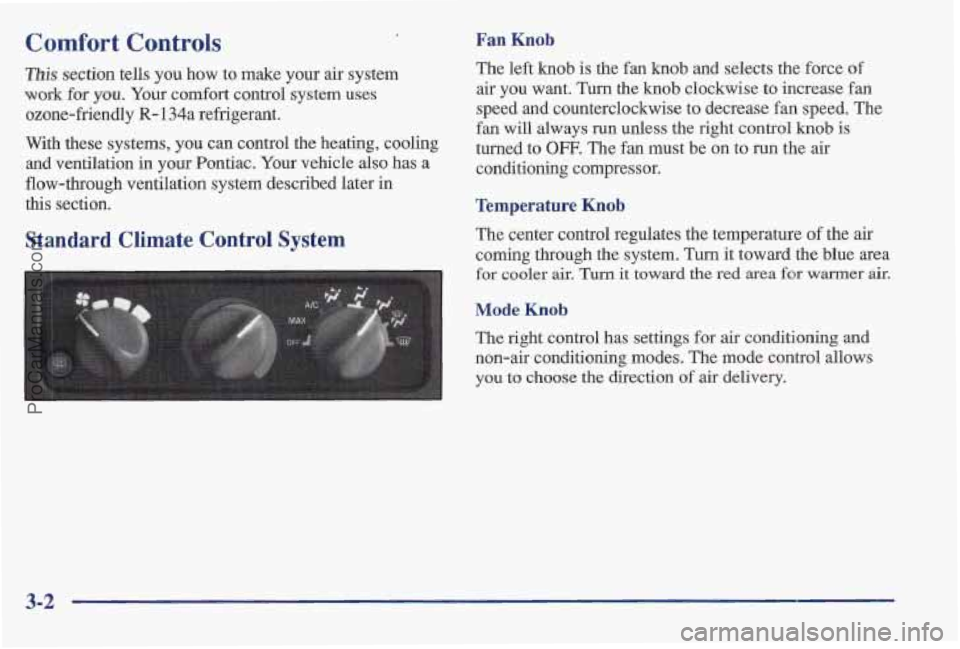
Comfort Controls
This section tells you how to make your air system
work for
you. Your comfort control system uses
ozone-friendly
R- 134a refrigerant.
With these systems, you can control the heating, cooling
and ventilation
in your Pontiac. Your vehicle also has a
flow-through ventilation system described later in
this section.
Standard Climate Control System
Fan Knob
The left knob is the fan knob and selects the force of
air you want. Turn the knob clockwise to increase fan
speed
and counterclockwise to decrease fan speed. The
fan will always
run unless the right control knob is
turned to
OFF. The fan must b'e on to run the air
conditioning compressor.
Temperature Knob
The center control regulates the temperature of the air
coming through the system. Turn it toward the blue area
for cooler air. Turn it toward the red area for warmer air.
Mode Knob
The right control has settings for air conditioning and
non-air conditioning modes. The mode control allows
you to choose
the direction of air delivery.
3-2
ProCarManuals.com
Page 145 of 405
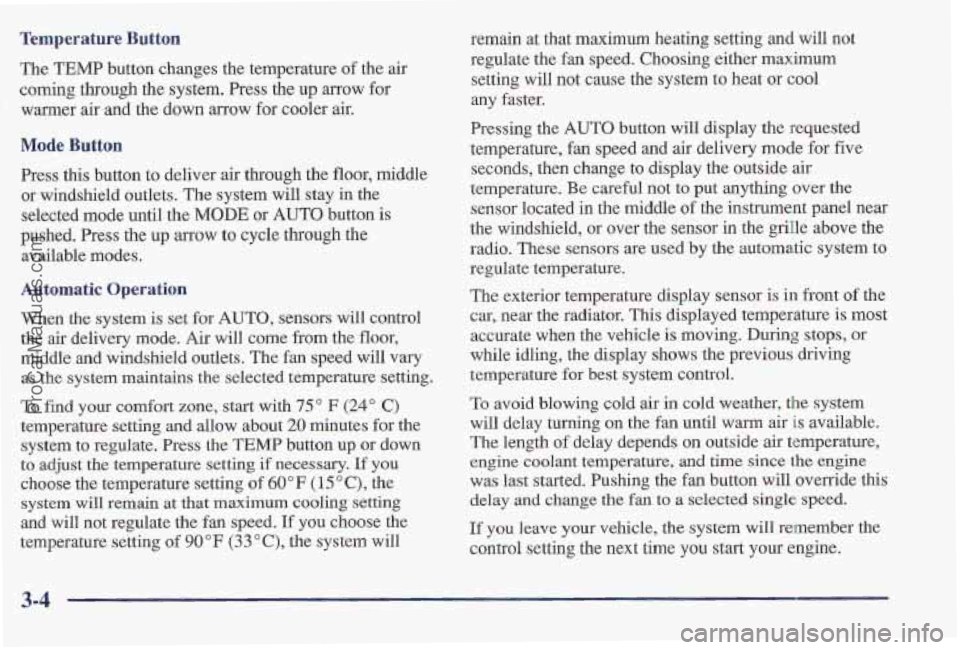
Tempmerature Button
The TEMP button changes the temperature of the air
coming
through the system. Press the up arrow for
warmer air-and the down arrow for cooler air.
Mode Button
Press this button to deliver air through the floor, middle
or windshiel'd outlets. The system will stay in the
selected mode until the
MODE or AUTO button is
pushed. Press the up arrow to cycle through the
available modes.
Automatic Operation
When the system is set for AUTO, sensors will control
the air delivery mode. Air will come from the floor,
middle and windshield outlets. The fan speed will vary
as the system maintains the selected temperature setting.
To find your comfort zone, start with 75 O F (24" C)
temperature setting and allow about 20 minutes for the
system to regulate. Press the TEMP button up or down
to adjust the temperature setting if necessary. If you
choose the temperature setting of 60°F (15 O C), the
system
will remain at that maximum cooling setting
and will not regulate the fan speed.
If you choose the
temperature setting
of 90°F (33 "C), the system will remain at that maximum heating setting and will not
regulate the
fan speed. Choosing either maximum
setting will not cause the system to heat or cool
any faster.
Pressing the
AUTO button will display the requested
temperature, fan speed and
air delivery mode for five
seconds, then change to display the outside air
temperature. Be careful not
to put anything over the
sensor located in the middle of the instrument panel near
the windshield, or over the sensor in the grille above the
radio. These sensors are used by the automatic system to
regulate temperature.
The exterior temperature display sensor is in front
of the
car, near the radiator. This displayed temperature is most
accurate when the vehicle is moving. During
stops, or
while idling, the display shows the previous dsaving
temperature
for best system control.
To avoid blowing cold air in cold weather, the system
will delay turning on the fan until warm air
is available.
The length
of delay depends on outside air temperature,
engine coolant temperature,
and time since the engine
was last started. Pushing the fan button will override this
delay and change the fan to a selected single speed.
If you leave your vehicle, the system will remember the
control setting the next time you start your engine.
3-4
ProCarManuals.com
Page 147 of 405
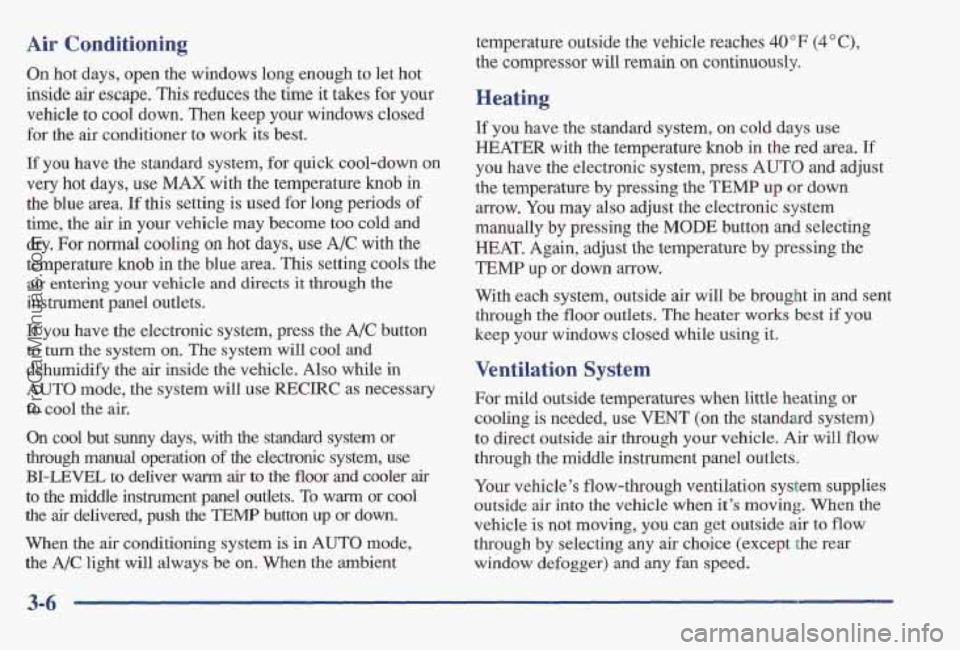
Air Conditioning
On hot days, open the windows long enough to let hot
inside
air escape. This reduces the time it takes for your
vehicle to cool down. Then keep your windows closed
for the air conditioner to work its best.
If
you have the standard system, for 'quick cool-down on
very hot days, use
MAX with the temperature knob in
the blue
area. If this setting is used for long periods of
time, the air in your vehicle may become too cold and
dry. For normal cooling on hot
days, use A/C with the
temperature
knob in the blue area. This setting cools the
air entering your vehicle and directs it through the
instrument panel outlets.
If you have the electronic system, press the A/C button
to turn
the system on. The system will cool and
dehumidify the air inside the vehicle.
Also while in
AUTO mode, the system will use RECIRC as necessary
to cool the air.
On cool but
sunny days, with the standard system or
through manual operation
of the electronic system, use
BI-LEVEL to deliver warm air to the floor and cooler air
to the middle instrument panel outlets. To warm or cool
the air delivered, push
the TEMP button up or down.
When the air conditioning system is in
AUTO mode,
the
A/C light will always be on. When the ambient
-/
temperature outside the vehicle reaches 40°F (4" C),
the compressor will remain on continuously.
Heating
If you have the standard system, on cold days use
HEATER with the temperature knob in the red area. If
you have the electronic system, press AUTO and adjust
the temperature by pressing the
TEMP up or down
arrow. You may also adjust the electronic system
nmnually
by pressing the MODE button and selecting
HEAT. Again, adjust the temperature by pressing the
TEMP up or down arrow.
With each system, outside air will
be brought in and sent
through the floor outlets. The heater works best if you
keep your windows closed while using it.
Ventilation System
For mild outside temperatures when little heating or
cooling
is needed, use VENT (on the standard system)
to direct outside air through your vehicle. Air will flow
through the middle instrument panel 'outlets.
Your vehicle's flow-through ventilation system supplies
outside air into the vehicle when
it's moving, When the
vehicle is not moving, you can get outside air to flow
through by selecting any air choice (except the rear
window defogger) and any fan
speed.
5-6
ProCarManuals.com
Page 150 of 405
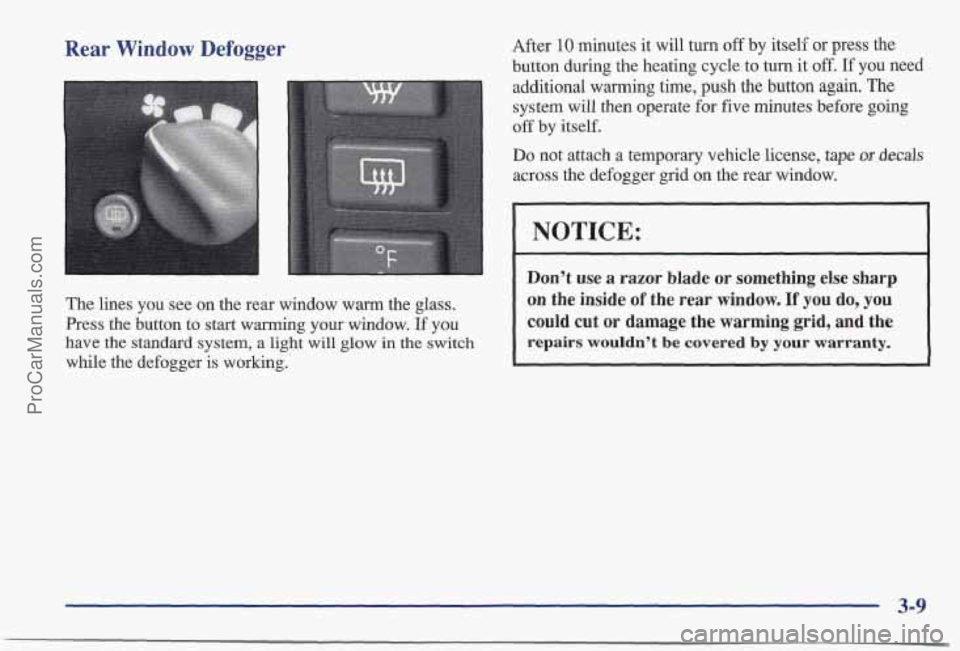
Rear Window Defogger
The lines you see on the rea window warm the glass.
Press the button to start warming your window. If you
have
the standard system, a light will glow in the switch
while the defogger is working. After
10 minutes
it will turn off by itself or press the
button during the heating cycle to turn it off.
If you need
additional warming time, push the button again.
The
system will then operate for five minutes before going
off by itself.
Do not attach a temporary vehicle license, tape or decals
across the defogger grid on the rear window.
NOTICE:
Don’t use a razor blade or something else sharp
on the inside
of the rear window. If you do, you
could cut or damage the warming grid, and the
repairs wouldn’t be covered by your warranty.
3-9
ProCarManuals.com
Page 214 of 405
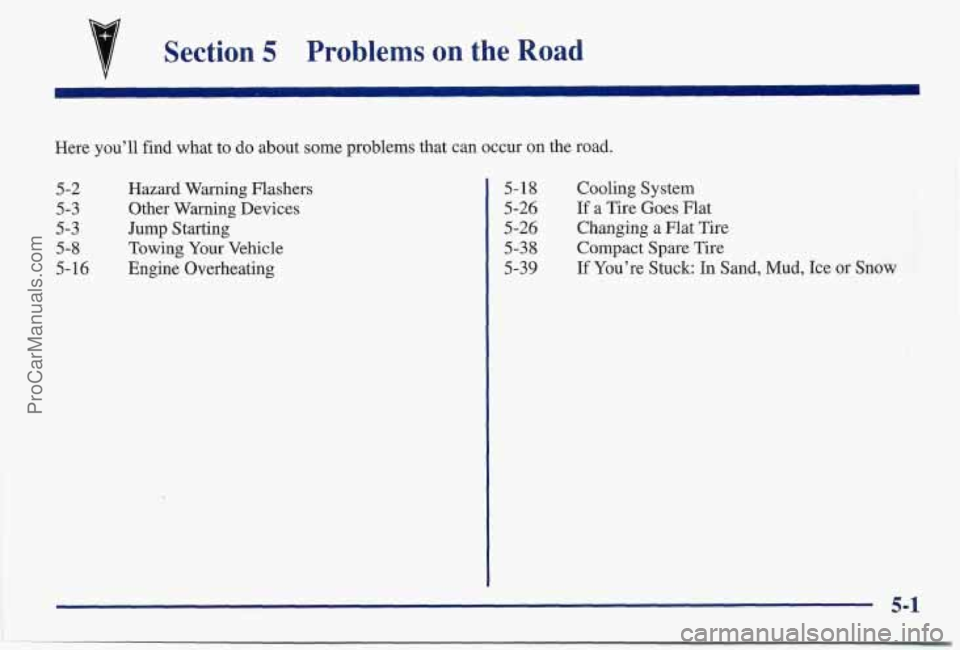
Section 5 Problems on the Road
Here you’ll find what to do about some problems that can occur on the road.
5-2
5-3
5-3
5-8
5-16 Hazard Warning
Flashers
Other Warning Devices
Jump Starting
Towing Your Vehicle
Engine Overheating 5-18
Cooling System
5-26 Changing a Flat Tire
5-38 Compact Spare Tire
5-39 If You’re Stuck: In Sand, Mud, Ice or Snow
5-26 If a Tire Goes Flat
5-1
ProCarManuals.com
Page 229 of 405
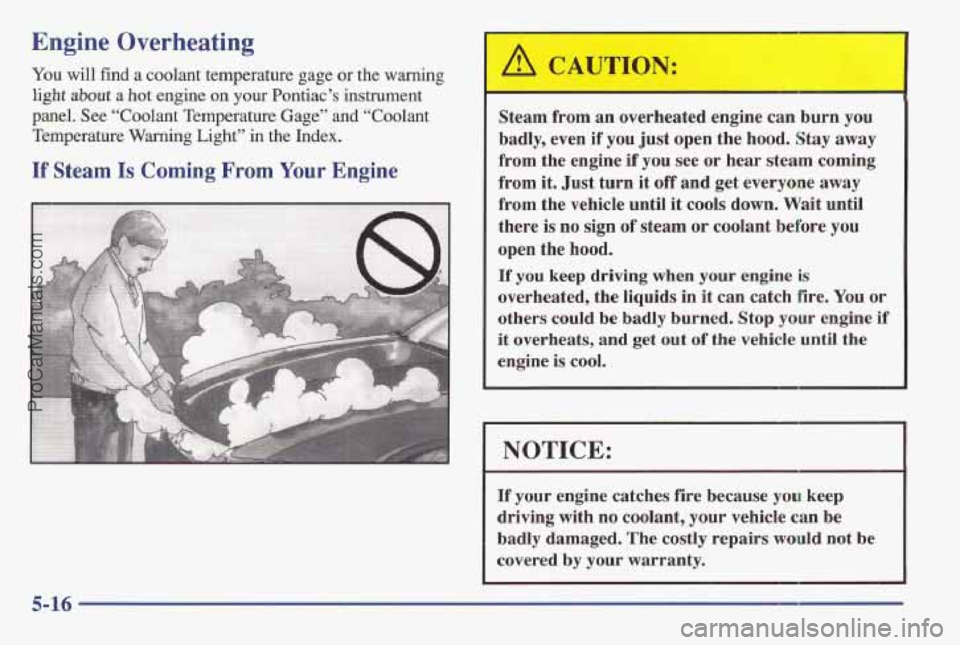
Engine Overheating
You will find a coolant temperature gage or the warning
light about a hot engine on your Pontiac’s instrument
panel. See “Coolant Temperature
G’age” and “Coolant
Temperature Warning Light” in the Index.
If Steam Is Coming From Your Engine
Steam from an overheated engine can burn you
badly, even if you just open the hood. Stay away
from the engine if
you see or hear steam coming
from it. Just turn it off and get everyone away
fro’m the vehicle until it cools down. Wait until
there
is no sign of steam or coolant before you
open
the ho’od.
If you keep driving when your engine is
overheated, the liquids in it can catch fire. You
or
others could be badly burned. Stop your engine if
it overheats, and get out of the vehicle until the
engine
is cool.
NOTICE:
If your engine catches fire because you keep
driving with no coolant, your vehicle can be
badly damaged. The costly repairs would not be ~
covered by your warranty.
5-16
ProCarManuals.com